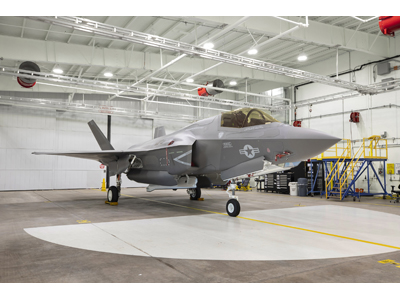Lockheed Martin delivered the 91st F-35 aircraft for the year, meeting the joint government and industry delivery target for 2018 and demonstrating the F-35 enterprise's ability to ramp to full rate production.
The 91 deliveries in 2018 represent nearly a 40 percent increase from 2017 and about a 100 percent production increase compared to 2016. Next year, Lockheed Martin is set to deliver more than 130 F-35s, representing yet another 40 percent increase in production.
More than 355 F-35s have now been delivered and are operating from 16 bases worldwide. More than 730 pilots and over 6,700 maintainers are trained, and the F-35 fleet has surpassed more than 175,000 cumulative flight hours. Ten nations are flying the F-35, seven countries have F-35s operating from a base on their home soils, four services have declared Initial Operating Capability (IOC) and two services have announced their F-35s have been used in combat operations.
In 2018, deliveries included 54 F-35s for the U.S., 21 for international partner nations and 16 for Foreign Military Sales (FMS) customers. The 91st aircraft is a U.S. Marine Corps F-35B, to be delivered to Marine Corps Air Station Beaufort, South Carolina.
"This milestone demonstrates the F-35 enterprise is prepared for full rate production and ready to deliver on increasing demand from our customers worldwide. Year-over-year, we have increased production, lowered costs, reduced build time and improved quality and on-time deliveries. Today, the F-35 is the most capable fighter jet in the world, and we're delivering more aircraft per year than any other fighter on the market at equal to or less cost." — Greg Ulmer, Lockheed Martin vice president and general manager of the F-35 program
Transitioning to Full Rate Production and Operational Sustainment
Through lessons learned, process efficiencies, production automation, facility and tooling upgrades, supply chain initiatives and continuous improvement actions, the F-35 enterprise has significantly improved efficiency and reduced cost.
The price of an F-35A is now $89.2 million, and the enterprise is on track to deliver an $80 million F-35A by 2020 (Lot 14), which is equal to or less than the price of less capable, 4th-generation aircraft.
The F-35's mission readiness and sustainment costs are also improving. Lockheed Martin's sustainment cost per aircraft per year decreased three years straight, by about 15 percent since 2015. The joint government and industry team is also taking aggressive actions to deliver 80 percent mission capable rates and reduce costs per flight hour by about 40 percent.
With stealth technology, supersonic speed, advanced sensors, weapons capacity and superior range, the F-35 is the most lethal, survivable and connected aircraft in the world. More than a fighter jet, the F-35's ability to collect, analyze and share data is a powerful force multiplier that enhances all airborne, surface and ground-based assets in the battlespace, enabling men and women in uniform to execute their missions and return home safely. In joint combat exercises, the F-35 has proven to be more than 20x more effective compared to legacy 4th-generation aircraft.

